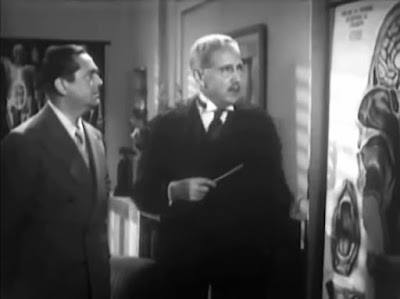TO LET: Unique property at 1313 Wellman Road. Includes hidden laboratory, lurking monster. Perfect starter home for defenceless couple... It's a fixer-upper alright but there's a solid structure beneath 1940's SON OF INGAGI...
RATING: 🕸🕸🕸
TO LET: Unique property at 1313 Wellman Road. Includes hidden laboratory, lurking monster. Perfect starter home for defenceless couple... It's a fixer-upper alright but there's a solid structure beneath 1940's SON OF INGAGI...
RATING: 🕸🕸🕸
The guests have gathered, the will's been read, the clock strikes twelve... and someone's DEAD! It's time to light a lantern and dust off your hiking boots as we prepare to keep pace with 1932's THE MONSTER WALKS...
Clocking in at an hour, this low-key Old Dark House movie won't trouble your little grey cells with extraneous twists or suspects but plods along purposefully, with some eerie touches and a capable cast.
It's a dark and corny night, and the curtains billow at the window of the room where Dr Earlton lies dead in his bed. Attorney Herbert Wilkes (Sidney Bracey) has arrived to read the will, while a small party of relatives and servants wait to find out what they'll inherit and who they'll have to kill to get their hands on it. Also in the house - but locked up in a cage in the cellar and not very happy about it - is the doctor's pet chimp, Yogi. "What makes him scream so?" asks the dead man's brother. "That's because of the corpse in the house," replies servant Hanns, relishing every word. "He remembers his dead master."
Of course not everyone is happy with the outcome of the will, which leaves everything to the doctor's daughter, Ruth - or alternatively to his brother in the event that anything happens to Ruth. (So she can't make a will of her own?) And, sure enough, that night, something does happen to Ruth, involving a hairy, ape-like hand emerging from a secret panel behind her bed and reaching for her throat!
Let's leave the plot there, as we're already halfway through, and reflect instead on the players - thankfully the kind of bunch who can make standing around and talking worth sitting back and listening to. While the stilted dialogue isn't always on their side ("Someone has made a second desperate attempt on Ruth's life!") these pros work near-miracles smoothing off some of its rougher edges. There's the commanding Martha Mattox from the original The Cat and the Canary, reprising her stern housekeeper bit with the addition of a few layers; Mischa Auer as her grown-up son, Hanns, who's all towering hair, dangling limbs and bitterness; and Willie Best as Exodus the driver, who's frankly insulted by the so-called comic relief he's asked to deliver here, but who remains a welcome addition to any cast.
I mentioned eerie touches earlier and, despite a fairly bland approach to the old house setting, I do think it provides the chills in places, especially during a quiet scene at the halfway mark... Following the stroke of midnight (filmed in thrilling real time!) a gruesome-looking hand slowly pulls a door closed and extinguishes a candle. It's as simple as that, but perfect nightmare fuel to my mind. The killer's 'alibi' (you'll know it when you see it) is also a terrific little detail and not given nearly enough screen time.
I was also delighted to hear one character exclaim "Pshaw!" - something I've come across in print before but never had the joy of hearing! All in all, while I may be being a tad generous with my cobweb rating below, it's refreshing to see an Old Dark House quickie that plays to its strengths and manages to carve out a niche simply by taking itself seriously.
RATING: 🕸🕸🕸
He MURDERS without mercy! But always sends a quick note beforehand to make sure you're available... So don't be dismissive if you receive a missive from... THE GORILLA!
Is he dead? Is he alive? Or is he caught in a waking nightmare too terrible to describe? Grab yourself a cup of cocoa and a stethoscope as we prepare to examine 1942's THE LIVING GHOST!

Putting a dampener on things, however, is that aforementioned romance between the leads, which is rammed in like a shoe on a sandwich and looks about as appetising. It's not really the fault of either actor: Joan Woodbury is lively and fun as Billie, while James Dunn (Nick) went on to win an Oscar just three years later for his work in A Tree Grows in Brooklyn. It's just clear that the writers hadn't seen any of the four Thin Man films released by this point, or at least hadn't learned anything about making 'banter' sexy and smart. Instead, Nick's come-ons come off as near-unbearable to modern ears, and the way he 'tests' their relationship borderline abusive. I know you can't judge older films as if they were released recently, but I've seen enough from the 40s to spot the worst offenders - and unfortunately this one's up there!
Thankfully, such moments are relatively brief, and other faces among the cast offer some diversion. Minerva Urecal fills the doomsayer role perfectly ("Hate and death are in this house... If you're wise you'll leave right now!") and the roguish yet dapper George Eldredge is enough to set the heart of any modern hipster a-flutter. The whole thing is clearly influenced by 1939's The Cat and the Canary and its ilk, which if you're anything like me will make it essential viewing. Just be ready to close your eyes and think of Bob Hope!
RATING: 🕸🕸
Do you hear the howling in the night outside Red Rock Tavern? Is it the wind? A wolf? Or is it... DEATH?! Find out, if you dare, as we visit 1936's apostrophe-free THE ROGUES TAVERN...